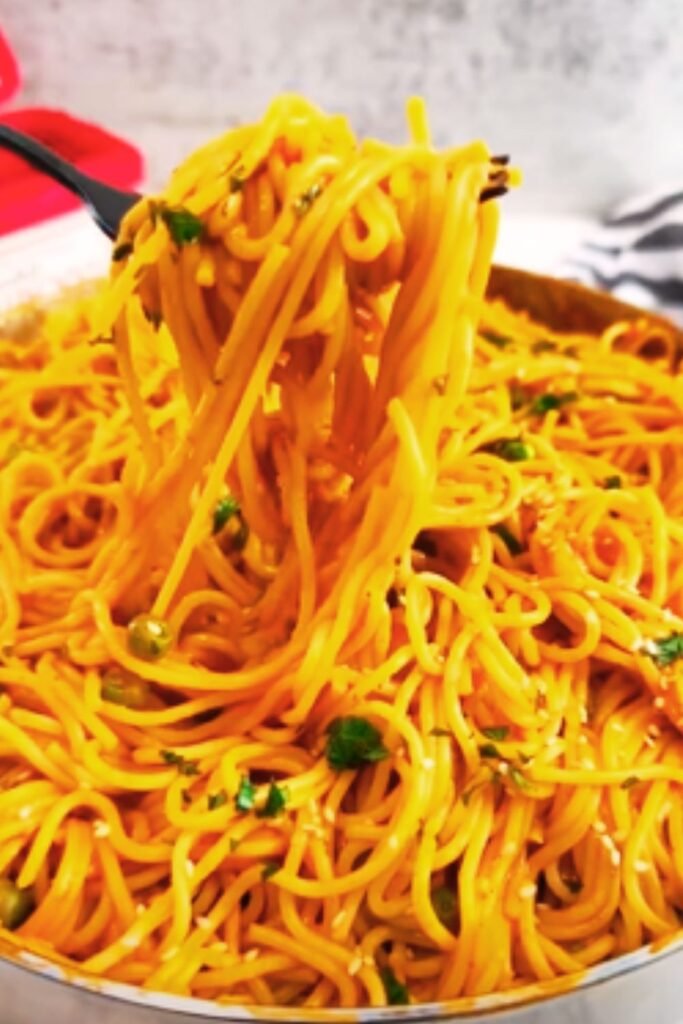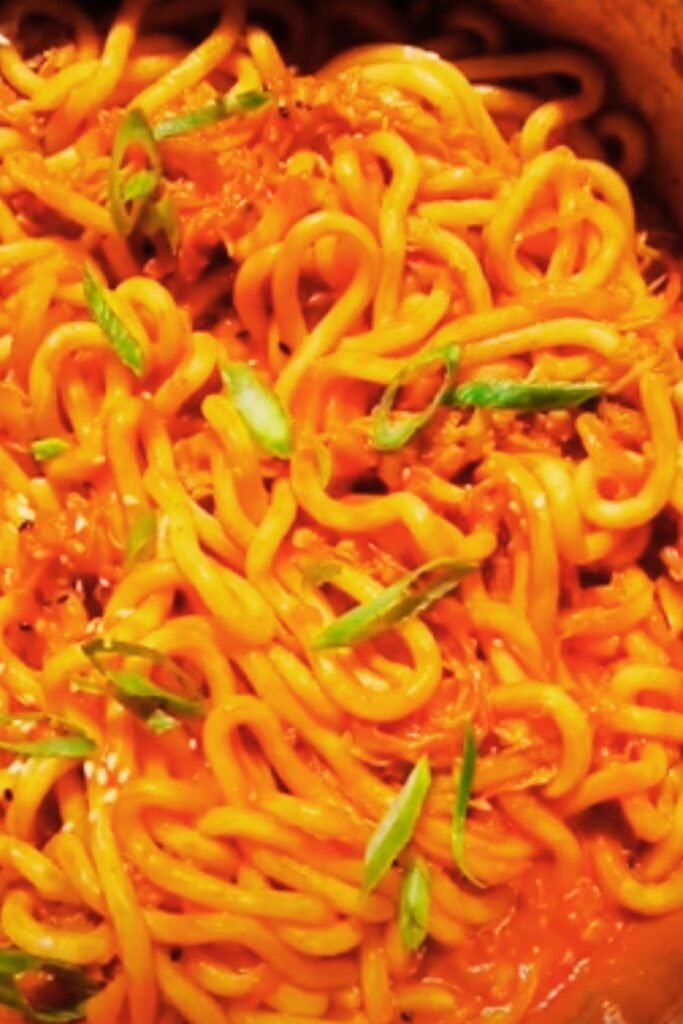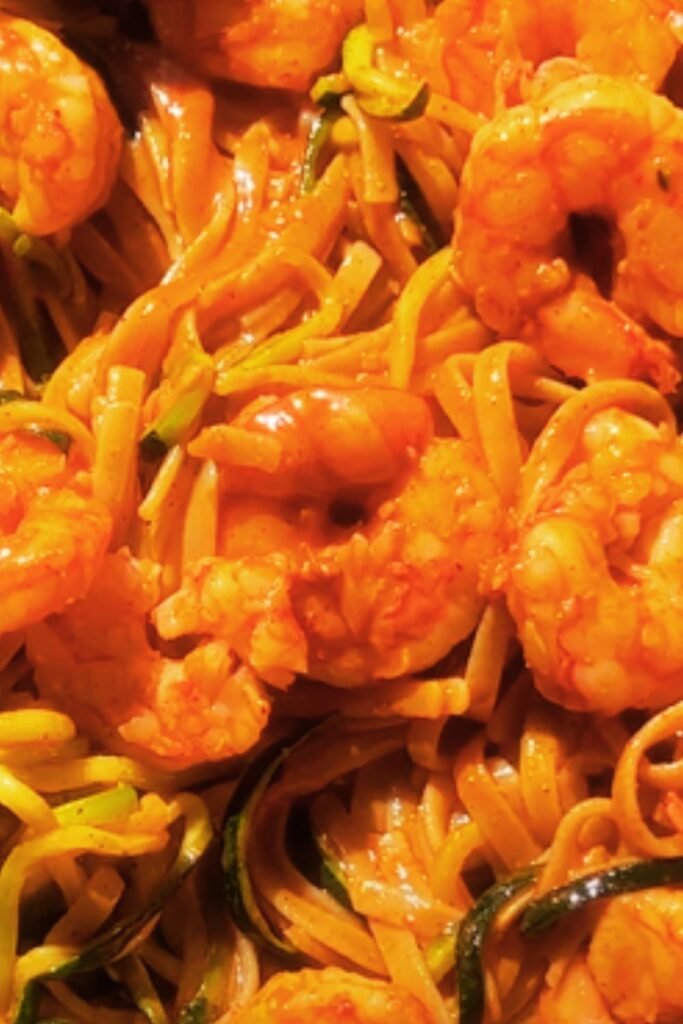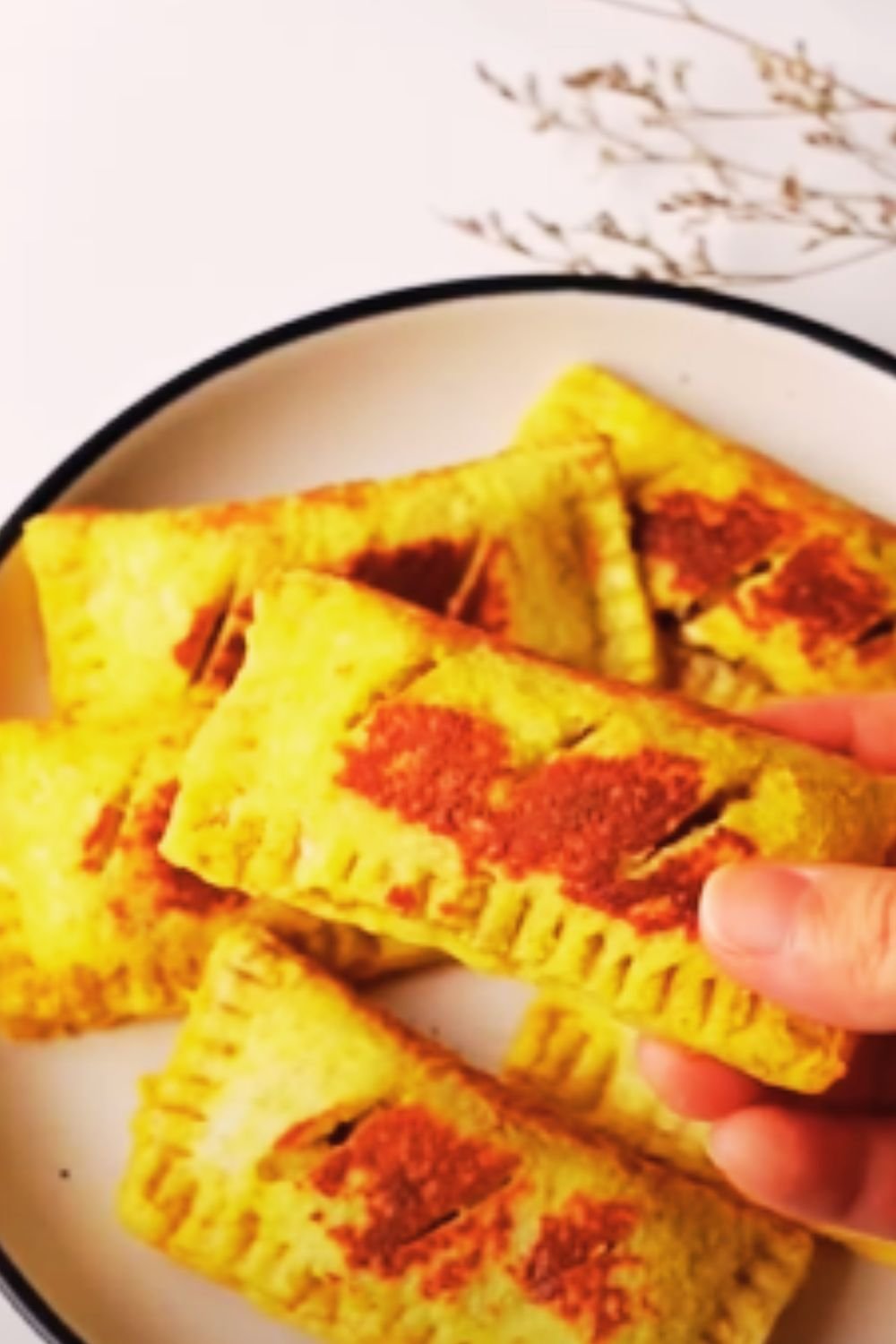My love affair with Korean cuisine began years ago, but I still vividly remember my first encounter with gochujang. That vibrant red paste, with its complex sweet-spicy-umami profile, left me utterly speechless. Today, I’m thrilled to share one of my absolute favorite weeknight recipes that showcases this remarkable ingredient: Gochujang Noodles.
These noodles strike that perfect balance between simplicity and flavor complexity. They’re quick enough for busy evenings yet sophisticated enough to impress dinner guests. Whether you’re a Korean food enthusiast or just beginning to explore this incredible cuisine, these noodles are guaranteed to become a regular in your meal rotation.
What is Gochujang?
Before diving into the recipe, let’s take a moment to appreciate the star ingredient. Gochujang isn’t just any hot sauce—it’s the backbone of countless Korean dishes and possesses a depth that’s truly unmatched.
Gochujang : A fermented Korean red chili paste made from glutinous rice, fermented soybeans, salt, and red chili powder. The fermentation process, which traditionally takes years, creates a rich, complex flavor profile that’s simultaneously spicy, sweet, and savory.
Gochugaru : The Korean red chili powder used in making gochujang. It has a distinctive flavor that differs from other chili powders—smokier and fruitier with a clean heat that doesn’t linger aggressively.
Fermentation : The process that gives gochujang its depth. During fermentation, starches break down into sugars, creating the paste’s characteristic sweetness while also developing complex umami notes.
The beauty of gochujang lies in its versatility. Unlike some hot sauces that deliver heat and nothing else, gochujang brings multiple dimensions to a dish. Its sweetness balances its heat, while glutamic acid-rich fermented soybeans provide that coveted umami punch.
The History Behind the Heat
Gochujang has been a staple in Korean kitchens for centuries, with references dating back to the 16th century. However, its origins likely stretch back much further. Before chili peppers arrived in Korea (introduced from the Americas in the early 17th century), similar fermented pastes were made with other ingredients.
What fascinates me about gochujang is how it reflects Korea’s agricultural heritage. Traditionally, families would make large batches collectively, storing it in earthenware pots called onggi. These porous containers allowed the paste to “breathe” during fermentation, contributing to its complex flavor development.
The traditional production of gochujang was a community event, often coinciding with the lunar calendar. Families would gather to prepare the paste, which would then ferment for months or even years. This communal preparation wasn’t just practical—it was cultural, strengthening community bonds.
Today, while many Korean families still make homemade gochujang, commercially produced versions have made this magnificent ingredient accessible worldwide. The quality and flavor profiles vary significantly between brands, though—something I discovered through much delicious experimentation!
Essential Ingredients for Perfect Gochujang Noodles
The beauty of this dish lies in its adaptability. While there are key components you shouldn’t skip, feel free to customize based on what you have available.
Core Ingredients:
- 8 oz (225g) noodles (wheat, rice, or sweet potato noodles work beautifully)
- 3-4 tablespoons gochujang paste
- 2 tablespoons sesame oil (preferably toasted)
- 2 tablespoons soy sauce (regular or low-sodium)
- 1 tablespoon rice vinegar
- 1 tablespoon honey or maple syrup
- 3-4 cloves garlic, minced
- 1-inch piece ginger, grated
- 2 green onions, sliced (separate white and green parts)
- 1 tablespoon toasted sesame seeds
Optional Add-ins:
- Protein options: tofu, chicken, beef, pork, or shrimp
- Vegetables: spinach, bok choy, mushrooms, carrots, bell peppers
- Toppings: soft-boiled egg, kimchi, nori sheets, bean sprouts
Noodle Varieties for Gochujang Sauce
Choosing the right noodle can significantly impact your dish. Here’s a breakdown of options, each bringing something unique to the table:
| Noodle Type | Texture | Flavor Profile | Cook Time | Best For | Notes |
|---|---|---|---|---|---|
| Somyeon (thin wheat noodles) | Light, delicate | Mild, slightly wheaty | 3-4 minutes | Quick meals | Absorbs sauce well; great for summer dishes |
| Dangmyeon (sweet potato glass noodles) | Chewy, slippery | Neutral, takes on flavors well | 6-8 minutes | Traditional preparations | Maintains texture when chilled; translucent appearance |
| Udon | Thick, chewy | Subtle wheat flavor | 8-10 minutes | Heartier dishes | Substantial mouthfeel; stands up to robust sauces |
| Soba (buckwheat) | Firm, slightly nutty | Earthy, distinctive | 4-5 minutes | Lighter variations | Great hot or cold; adds nutritional value |
| Ramen | Wavy, springy | Wheaty, can be alkaline | 2-3 minutes | Quick comfort food | Perfect for broth-heavy versions; convenient |
| Rice Noodles | Soft, tender | Neutral, slightly sweet | 2-4 minutes | Gluten-free option | More delicate; needs gentle handling |
My personal favorite is dangmyeon (sweet potato glass noodles). Their chewy texture and ability to soak up sauce while maintaining their integrity make them perfect for this dish. Plus, there’s something mesmerizing about how they transform from opaque to translucent during cooking!

The Perfect Gochujang Sauce Ratio
The sauce is the heart of this dish, and getting the balance right makes all the difference. After countless test batches (a delicious research process, I assure you), I’ve landed on this perfect ratio for four servings:
| Ingredient | Amount | Purpose in Sauce | Substitution Options |
|---|---|---|---|
| Gochujang | 3-4 Tbsp | Provides heat, sweetness, umami | Sriracha mixed with miso (less complex but workable) |
| Sesame Oil | 2 Tbsp | Adds nuttiness and silky texture | Perilla oil (if available) or neutral oil with sesame seeds |
| Soy Sauce | 2 Tbsp | Delivers saltiness and depth | Tamari (gluten-free) or coconut aminos (less salty) |
| Rice Vinegar | 1 Tbsp | Balances with acidity | Apple cider vinegar or lime juice |
| Sweetener | 1 Tbsp | Rounds out heat and acidity | Honey, maple syrup, brown sugar, or agave |
| Garlic | 3-4 cloves | Adds aromatic pungency | Garlic powder (1 tsp) but fresh is much better |
| Ginger | 1-inch piece | Contributes warmth and brightness | Ginger powder (1/2 tsp) but fresh is preferred |
| Water | 2-4 Tbsp | Adjusts consistency | Stock for more flavor |
The beauty of this sauce lies in its adaptability. If you prefer more heat, increase the gochujang. More tanginess? Add an extra splash of rice vinegar. The sauce should coat the noodles generously without pooling at the bottom of the bowl.
I find that whisking all sauce ingredients together before adding to the noodles ensures even distribution and helps the flavors meld beautifully. For an even deeper flavor profile, try mixing the sauce ingredients a few hours ahead of time and letting them mingle in the refrigerator.
Step-by-Step Cooking Process
Let me walk you through the process of creating these magnificent noodles:
- Prep your workspace
- Gather all ingredients and measure them out
- Chop vegetables and protein into bite-sized pieces
- Mix sauce ingredients in a small bowl and set aside
- Cook the noodles
- Bring a large pot of water to a rolling boil
- Add noodles and cook according to package directions
- Test for doneness—they should have some bite (especially important for sweet potato noodles)
- Drain and rinse under cold water to stop cooking process
- Prepare protein (if using)
- Heat 1 tablespoon oil in a large wok or skillet over medium-high heat
- Add protein and cook until done (times vary by type)
- Remove and set aside
- Stir-fry vegetables
- In the same pan, add a touch more oil if needed
- Add white parts of green onions, garlic, and ginger, stirring for 30 seconds
- Add harder vegetables first (carrots, bell peppers), cooking for 2-3 minutes
- Add quicker-cooking vegetables (spinach, bok choy) last
- Combine everything
- Return noodles to the pan
- Add sauce and toss until everything is well-coated
- Add cooked protein back to the pan
- Stir-fry for another minute to ensure everything is hot and well-combined
- Garnish and serve
- Transfer to serving bowls
- Top with green parts of onions, sesame seeds, and any additional garnishes
- Serve immediately while hot

Common Pitfalls and How to Avoid Them
Even the simplest dishes can go awry. Here are some issues I’ve encountered and how I’ve learned to overcome them:
Overcooked Noodles
Nothing ruins the texture of this dish faster than mushy noodles. Different varieties require different cooking times, so always check package instructions. As a general rule, I cook noodles about 1 minute less than suggested for the perfect texture, as they’ll continue cooking slightly when mixed with the hot sauce.
Sauce Too Thick or Thin
The sauce should coat the noodles nicely without being gloppy or watery. If it’s too thick, add water or stock a tablespoon at a time until you reach the desired consistency. If too thin, a quick simmer can help reduce and thicken it.
Unbalanced Flavor
Gochujang varies significantly in potency between brands. Start with less and add more to taste. Remember that the heat will bloom as the dish sits, so what seems mild at first might pack more punch a few minutes later.
Vegetables Unevenly Cooked
Stagger the addition of vegetables based on cooking time. Harder vegetables like carrots need more time, while leafy greens need just a few seconds. Cutting everything to a similar size also helps ensure even cooking.
Serving Suggestions and Pairing Ideas
These noodles are substantial enough to serve as a main dish, but they also work beautifully as part of a larger Korean-inspired spread.
Perfect Accompaniments:
- Kimchi: The fermented tang complements the spicy-sweet noodles perfectly
- Pickled vegetables: Quick-pickled cucumbers or radishes add freshness
- Banchan (small side dishes): Spinach namul, gamja jorim (braised potatoes), or kongnamul (bean sprouts)
- Japchae: For a noodle lover’s feast, pair with these sweet potato starch noodles
- Fresh lettuce or perilla leaves: For wrapping bites of noodles
- Iced barley tea: The toasty flavor balances the spice beautifully
- Sparkling water with a squeeze of lime: Refreshing counterpoint to the rich flavors
For a complete meal experience, consider serving these noodles with:
- Korean fried chicken: The crispy exterior and juicy interior create a delightful textural contrast
- Doenjang jjigae (soybean paste stew): Its earthy depth complements the brighter notes in the noodles
- Japchae (stir-fried glass noodles): For a noodle lover’s feast
- Pajeon (Korean savory pancake): Great for soaking up extra sauce
Dietary Adaptations and Nutritional Information
One of the reasons I love this recipe is its adaptability to various dietary needs:
Gluten-Free Version
- Use rice noodles or 100% sweet potato noodles
- Substitute regular soy sauce with tamari or coconut aminos
- Check your gochujang—some contain wheat; look for certified gluten-free brands
Vegan Adaptation
- Use maple syrup or agave instead of honey
- Add tofu, tempeh, or seitan for protein
- Bulk up with extra vegetables like mushrooms for umami
Lower-Sodium Option
- Use low-sodium soy sauce
- Reduce soy sauce by half and add a splash of lime juice
- Increase aromatic ingredients like garlic and ginger to maintain flavor complexity
Nutritional Profile (approximate per serving with sweet potato noodles)
| Nutrient | Amount | % Daily Value* |
|---|---|---|
| Calories | 380-420 | – |
| Protein | 8-10g | 16-20% |
| Carbohydrates | 65-70g | 22-23% |
| Dietary Fiber | 4-5g | 16-20% |
| Sugars | 7-9g | – |
| Fat | 12-15g | 18-23% |
| Saturated Fat | 2-3g | 10-15% |
| Sodium | 800-900mg | 33-38% |
| Potassium | 300-350mg | 8-10% |
| Iron | 2-3mg | 11-17% |
| Vitamin A | 3000-3500 IU | 60-70% |
| Vitamin C | 15-20mg | 25-33% |
*Based on a 2,000 calorie diet
The nutritional profile will vary based on your choice of noodles, protein, and vegetables. Sweet potato noodles tend to be slightly lower in calories than wheat noodles but higher in carbohydrates.

Make-Ahead and Storage Tips
Meal prep enthusiasts, rejoice! These noodles work wonderfully for planned leftovers:
Make-Ahead Options:
- Sauce: Can be prepared up to 3 days ahead and stored in an airtight container in the refrigerator
- Vegetables: Clean, chop, and store in airtight containers up to 2 days ahead
- Protein: Cook, cool, and refrigerate up to 2 days before final assembly
- Complete dish: Fully prepare up to 2 days ahead, but add fresh garnishes just before serving
Storage Guidelines:
- Refrigeration: Store in airtight containers for 3-4 days
- Freezing: Not recommended for the complete dish as noodles can become mushy
- Reheating: Add a splash of water or broth when reheating to refresh the sauce
Reviving Leftover Noodles:
Leftover noodles tend to absorb sauce and can become dry. Here’s how to bring them back to life:
- Add a splash of water or broth to the noodles
- Cover with a damp paper towel when microwaving
- Stir in a teaspoon of sesame oil after reheating to restore silkiness
- Add fresh garnishes (green onions, sesame seeds) to brighten up the dish
Seasonal Variations
One of the joys of this recipe is how easily it adapts to seasonal produce:
Spring
- Add tender asparagus tips and snap peas
- Incorporate spring onions and young spinach
- Garnish with fresh pea shoots
Summer
- Mix in thinly sliced zucchini and yellow squash
- Add corn kernels for sweetness and texture
- Finish with fresh herbs like perilla leaves or cilantro
Fall
- Include diced butternut squash (pre-roasted for best texture)
- Add sliced mushrooms like shiitake or oyster
- Incorporate hearty greens like kale or chard
Winter
- Mix in roasted brussels sprouts or cauliflower
- Add root vegetables like sweet potatoes or turnips (pre-roasted)
- Increase the gochujang slightly for extra warmth
Frequently Asked Questions
Q: Can I make these noodles less spicy while maintaining the flavor?
A: Absolutely! Reduce the gochujang by half and replace it with an equal amount of doenjang (Korean fermented soybean paste) or red miso. This maintains the umami and depth while reducing heat. Another option is to add a tablespoon of butter to the sauce, which helps mellow the spice.
Q: I can’t find gochujang locally. What’s the best substitute?
A: While nothing truly replicates gochujang’s unique flavor profile, you can create a workable substitute by mixing 2 tablespoons red miso paste, 1 tablespoon hot sauce (like Sriracha), 1 teaspoon honey, and 1/2 teaspoon smoked paprika. Alternatively, order it online—many brands ship worldwide, and once opened, it keeps for months in the refrigerator.
Q: How do I prevent sweet potato noodles from sticking together?
A: First, don’t overcook them—they should maintain a chewy bite. Immediately after draining, rinse thoroughly with cold water and toss with a teaspoon of sesame oil. If preparing ahead, store them in cold water in the refrigerator, then drain just before using.
Q: Can I make this dish ahead for a dinner party?
A: Yes! Prepare all components separately up to a day ahead: cook and store noodles (tossed with a bit of oil), prepare sauce, and chop vegetables. Store everything separately in the refrigerator. About 10 minutes before serving, quickly stir-fry everything together. This approach actually allows the flavors to develop more deeply.
Q: Is there a good way to incorporate seafood into this dish?
A: Shrimp works wonderfully—marinate peeled shrimp in a mixture of minced garlic, ginger, and a splash of soy sauce for 15 minutes before cooking. Cook them just until pink (about 2 minutes per side) before adding noodles and sauce. Squid is also excellent but requires very brief cooking (30-60 seconds) to prevent toughening.
Q: How can I make this more substantial for a hungry family?
A: Double the protein (chicken, beef, or tofu work well) and add extra vegetables. Serving a soft-boiled egg on top adds richness and protein. For growing appetites, you can increase the noodle portion by 50% without needing to adjust the sauce significantly.
My Personal Gochujang Journey
I first encountered gochujang during a cooking class I took while traveling. The instructor explained that gochujang wasn’t just an ingredient but a cultural cornerstone—something that connected generations of Korean families through its production and use.
What struck me most was how this humble paste could transform the simplest ingredients into something extraordinary. The balance of sweet, spicy, and savory seemed almost magical, and I was determined to incorporate it into my cooking repertoire.
My first attempts were disastrous—I treated gochujang like hot sauce, adding far too much and overwhelming every other flavor. Over time, I learned to respect its potency and complexity, using it as a foundation rather than an accent.
These noodles represent years of experimentation and learning. They honor the traditional use of gochujang while adapting to ingredients available in my local market. Every time I prepare them, I’m reminded of that first cooking class and the culinary journey it inspired.
Whether you’re a seasoned Korean food enthusiast or just beginning to explore this incredible cuisine, I hope these noodles bring as much joy to your table as they have to mine. The beauty of cooking lies in adaptation and personalization—so don’t be afraid to make this recipe your own!


